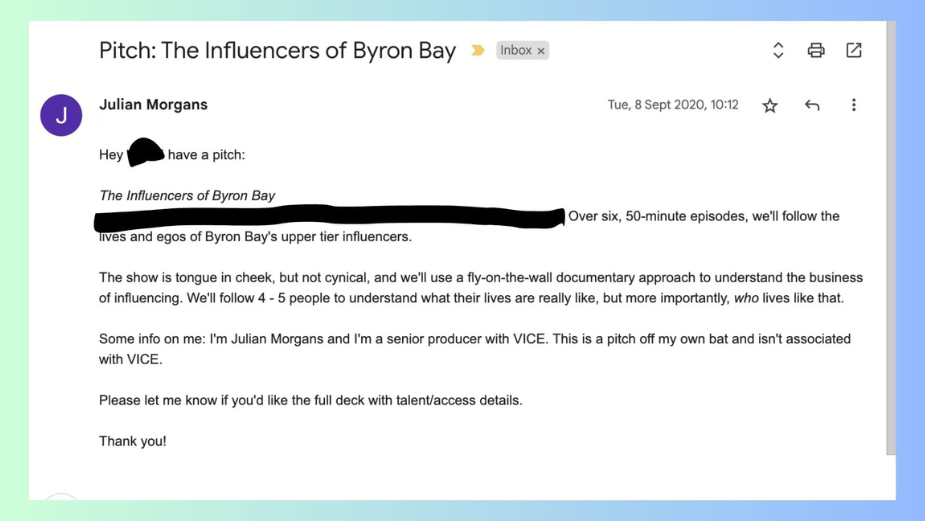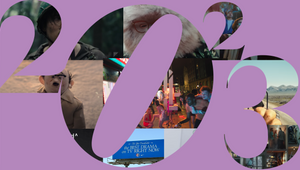
What I Learned from Selling a Show to Netflix

In 2020 I saw a Tweet from a woman who’d been hired as the head of Netflix Australia. Her Tweet said she wanted to commission local shows, and she was accepting pitches.
I’d never pitched a TV show before. But I’d worked at VICE a long time where I’d made lots of short documentaries, so I had some experience. Plus I had what felt like a great idea, so I wrote it up and sent it with my fingers crossed. And somehow, 18 months later, my original idea debuted as a Netflix show called Byron Baes.
Selling Byron Baes was probably one of the most fun periods of my life. Friends and ex-girlfriends suddenly thought I was a big deal, and I got phone calls from actual newspapers. But I learned lots of useful things too, like how to sell ideas and how to navigate the global streamer market. But I also learned something bigger. Like how if you’re a creatively minded ambitious person, a big success never feels big enough. It was an interesting lesson, and one that I’d like to address at the end of this article. But let’s cover the other thought leader stuff first.

caption: The email I originally wrote to Netflix with the first line scrubbed out because it’ll get me in trouble. Why? You’ll never know.
1: The difference between good and great ideas.
Good ideas are a dime a dozen. Most creative people have good ideas all the time, but the challenge is identifying the great ones. Because great ideas are rare and sometimes they can look like good ones, or even bad ones.
Byron Baes seemed like a good idea when it first appeared in my head, but I was suspicious. I’d spent an evening on a friend’s balcony in Byron, as house lights came up through the hinterland. And as the lights came up I could see they were huge houses, each with infinity pools and driveways like runways and I thought to myself, this place has really changed. And then I got lost in a daydream about a Northern Rivers version of Real Housewives, only in my daydream the housewives were all influencers, and I smiled, because it felt like a good idea.
Now, let’s freeze frame on this moment because I want to unpack something.
2: Great ideas either refute or confirm.
At first glance, I liked the influencers idea because it affirmed something many people already felt: that Byron Bay had sold out. There’s a million ways to measure content ideas, but I’ve got this theory that the best is something I call affirm or refute. And the idea is that all content should either affirm or refute something the audience already believes.
Take Forrest Gump for example. At its core, that film affirms the very American notion that if you’re true to yourself and hard-working you can become a multimillionaire athlete (even if you’re a complete idiot). Star Wars, Harry Potter and The Matrix leverage the same beliefs about the capacity for average people to become extraordinary.
Meanwhile Barbie is a great study in refutation, because it calls out multiple beliefs at the same time. Broadly speaking, I’d argue the film enjoyed immediate appeal because Greta Gerwig refuted the idea of Barbie as a squeaky clean archetype of conservative family values. The initial genius was infusing a very old, traditional brand with modern, indie film humour. Then from there, it rejects a whole bunch of other cliches, like the notion that successful people can’t be messy, or that everyone needs to find a Ken to be happy.
And I’m not going to pretend like my reality TV show was in the same league as Star Wars or Barbie, but its appeal utilised a similar mechanism. Simply by focusing on Byron’s influencers through a Real Housewives lens, it affirmed a widely-held sense that Byron Bay had become a small version of Beverly Hills. The concept whispers yes you’re right about Byron, while promising to show you some really hot people yelling at each other. In short, the concept confirmed something the audience already believed, and wanted to see.
Finally, the clincher was that it leveraged Bryon’s international fame, which is always crucial for a US audience. Hot tip: Australian films and TV are far more likely to get made if they appeal to a US audience (keep in mind US audiences only care about things that happen in the US or to people from the US). Oh and the other thing: IP is king and if you’re not adapting a famous Marvel character, a famous novel, or a famous historical figure, then a famous town that’s home to Chris Hemsworth will suffice).
3: Ok, here’s what I was saying about the difference between good and great ideas
Like I said, I’m suspicious of ideas that initially feel great. I was editor of VICE for years, so a large part of my job was receiving pitches from people who believed they had a great idea for articles or videos. And I was always surprised by the middling standard of ideas, which I attribute to the fact that most people don’t stress test their concepts.
Here’s the thing. If you’ve got an idea for a TV show, tell a few people about your idea and then watch them closely. Do they understand your idea quickly? Do they grin widely? Do they ask questions excitedly? Or do they smile politely and say something like “I love it” in a tone that suggests they didn’t get it?
That’s the acid test. Good ideas elicit smiles and nodding heads. But truly great ideas give people a little jolt of energy. A great idea affirms or refutes a belief they already hold in a way that makes them feel seen, and you’ll observe that moment of self-recognition in their body language. But the only way to find out is to say your idea out loud.
So that’s what I started doing after I saw this Tweet from the head of Netflix. I just started testing my idea out on friends who watch a lot of TV, and the response was positive. Lots of people laughed like it was the punchline to a joke and I decided I was onto something. So I sent it to Netflix.

The first page of my pitch deck
4: How to develop and pitch a TV show
The image above was from the front page of my pitch deck for The Influencers of Byron Bay, which is what I was calling the show before the good people at Netflix came up with a much better idea.
Now, if you’re a total novice to this world, you should know that a pitch deck is a PDF that lays out what the show is about, what it looks like, how it works and who it features. There’s an industry standard for formatting a pitch deck so do some googling for structure.
I started by soft-pitching, which means that I started with an email that laid out the show’s premise in a single paragraph. Then, when I got a positive response, I sent over a short deck and again, the reception was positive and there was talk of a Zoom call.
At that point, I started feeling 50 percent excited and 50 percent totally out of my depth, so I called VICE’s former head of production, who I sometimes turned to for advice. And that was probably the single smartest move I made.
If you’re anything like me, which means creatively skilled but bad at everything else, I would highly recommend getting yourself a business partner. And that’s because transforming a rough idea into a sellable proposition is a skill of its own, and building a business structure around creative thinking is vital. My mentor became my friend and eventually came on board as a business partner, and without her Byron Baes would have never been made.
Together, we developed the idea with Netflix, and then partnered with an established production company that could do the heavy lifting of pre-production, before we were greenlit for production.
This was how we co-founded Superreal, which is a company that makes unscripted TV and podcasts. That was two years ago, and we’ve now got a suite of other shows in development. But it all started with that first Netflix deal, which I later realised was anomalously easy.
The truth is that a large part of selling TV shows relies on luck. That’s not just my experience, it’s something that everyone in the TV business agrees on. And why is that? I once heard the legendary film and TV producer Jerry Bruckheimer addressing the issue of luck in an interview he did on Rob Lowe’s podcast. He was talking about trying to pitch CSI back in the late 90s. And every single network passed on it, until they finally sold it in their last meeting. And here’s Jerry’s explanation:
“It's all about [the broadcaster's] needs. It’s one of the things that creative people forget, that the world doesn't revolve around them. Like if I go to a network to pitch a comedy and I get turned down, I think it's on me. But the truth is they’re like ‘we just already bought three comedies. We have room for three comedies, we bought three and you're the fourth.’ And that's the part of the business that young actors and young writers and young directors don't don't get to see, is the just nuts and bolts of decision making. And it has nothing to do with how they feel about you or your project.”
And that’s something I didn’t realise when we sold Baes. There was immediate interest, but it’s just because we happened to have the right idea at the right time, and I’d sent it to a person who was new in their job and wasn't already buried under a million other pitches.
Screenshot of angry DMs

From left: here’s a screenshot of my Instagram outbox. On right is a message with my *hilarious* grammar-based retort.
5: What I learned about the nature of success
Byron Baes’ announcement in May 2021 was met with an immediate backlash from the residents of Byron Bay. I’ve never felt particularly territorial or tribal, in the sense that if someone criticised Melbourne, or my home suburb of Mordialloc, I wouldn’t care. But Byron people really, really cared.
There were protests and the mayor said angry things on the radio and within days it was all over the news and I received an avalanche of homicidal DMs. The above image is a screenshot I took of my outbox, and that was about one 50th of the total number. I was also getting phone calls from A Current Affair, The Guardian and The New York Times, and for one brief and glorious moment Australia’s cultural eyeball had glanced in my general direction and I loved it.
Let’s be honest. Everyone in creative industries always talks about their love of the craft. They talk about their passion for the work, and how they obtain joy from collaboration. But they rarely admit to enjoying attention, which I think is kind of ridiculous. Every creative person I’ve ever met derives some percentage of their occupational meaning from attention, and I think it’s ok to admit that. But attention is reliant on other people, which means creative jobs come with a lack of control. So in my experience, selling a show swelled my ego deliciously, and then fizzled quickly and left a quiet void.
That’s not to say I’ve stopped pitching shows and moved to a Tibetan monastery. Far from it. Superreal is going great and we should have a new show out next year. In addition, I’m also working at Sunday Gravy where I’m helping brands turn their messaging into content. Just the thing is that I know that launching a TV show won’t bring the kind of conclusive happiness I’d originally imagined. But that’s ok. I know that now, and I’m fine with it.
Ultimately, I think dealing in creativity isn’t really a job. Artistic expression is more of a compulsion and I couldn't stop even if I wanted to. So I’m totally content working in this happiness ponzi-scheme where the only choice is to keep going. It makes no sense, but I relish the process, and I suspect that if you’ve made it this far through a LinkedIn article, then you probably do too.
You can follow me on Instagram and of course, LinkedIn. And if you have any questions, or you’d like some help bringing your brand to life in new ways you can email me at Sunday Gravy, where I’m the Editorial Director: julian@sundaygravy.com.au










